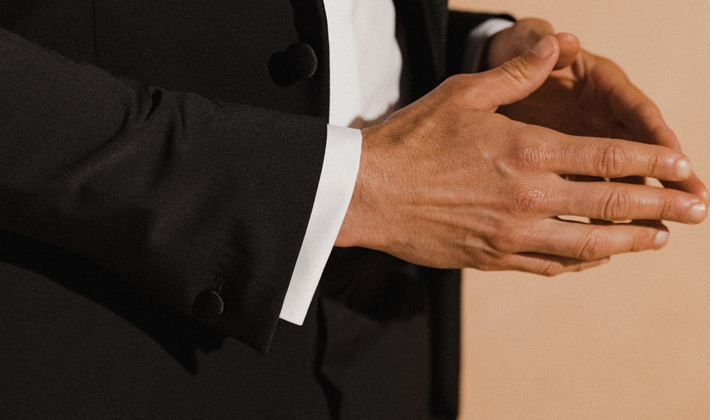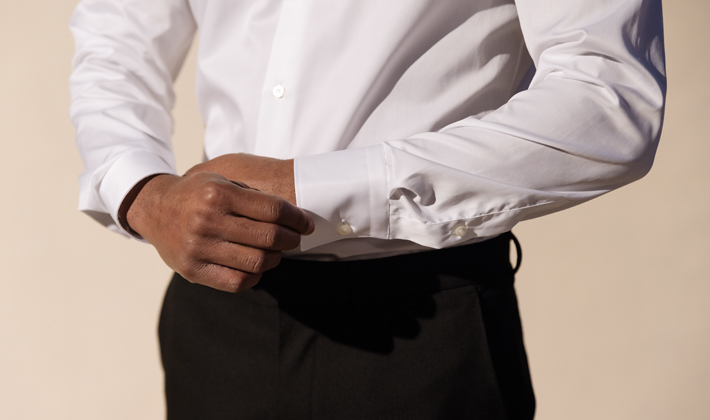Black Tie Dress Code Explained
Master the black tie dress code for men with our comprehensive guide

Navigating the world of formal events can be daunting, especially when the invitation specifies "black tie." Read this guide to discover the specific requirements of the black tie dress code.
What Is the Black Tie Dress Code?
Black tie is a formal dress code for special events that typically happen in the evening. It is more formal than cocktail attire but less formal than white tie. The black tie dress code originated in 19th century England as a less formal alternative to white tie.
Dressing for a black tie event doesn’t need to be complex. A black tie outfit typically consists of: a dinner jacket, formal trousers, a black tie shirt, a bow tie, formal shoes, socks and accessories.
The Rules of Black Tie Dressing
To master black tie, ensure your outfit follows the guidelines below.

Dinner Jacket (Tuxedo Jacket)
- Colour: Black or midnight blue are classic choices. Deep jewel tones are suitable for velvet jackets in winter.
- Fabric: Worsted wool is classic; velvet is a luxurious winter option.
- Style: Single-breasted (1 or 2 buttons; 1 button is more modern) or double-breasted.
- Lapel Material: Satin (shiny) or grosgrain (textured) material.
- Lapel Shape: Peaked lapels are standard; shawl lapels are a softer alternative. Avoid notch lapels.
- Pockets: Jetted pockets are preferred. Avoid flap pockets.
- Vents: Ventless is most formal, double vents are most contemporary.

Formal Trousers
- Colour & Fabric: Match the dinner jacket, for example black with black, midnight blue with midnight blue. If the jacket is velvet or an unusual colour, trousers must be black (in a formal material such as barathea or high-twist wool).
- Style: Satin or grosgrain side stripe (matching to your dinner jacket’s lapels). Avoid pleats, cuffs, and belt loops. Suspenders or braces are recommended.
- Fit: Tailored, comfortable, tapered fit. Your trouser hem should gently touch shoes or create a slight trouser break.

Formal Shirt
- Colour: White
- Fabric: Cotton (or linen for warmer climates).
- Front Style: Plain, pleated, or textured marcella.
- Collar: Turn-down collar (point or spread) is most common. Wing collars are also acceptable.
- Cuffs: French cuffs are preferred for black tie events.

Bow Tie
- Colour: Black is standard, but midnight blue or dark burgundy can complement certain dinner jackets. Note: Bold colours or patterns are generally unsuitable for black tie.
- Fabric: Silk.
- Style: Self-tied only. The finished bow should not be wider than your shirt collar.

Formal Shoes
- Colour: Black.
- Style: Plain-toe Oxfords (most traditional) or opera pumps/slippers (less formal, ideally in black velvet).
- Material: Highly polished leather, ideally patent leather.

Socks
- Colour: Black.
- Material: Fine-gauge silk or wool blend.
- Length: Over-the-calf (essential to avoid showing skin when seated).

Accessories
Cufflinks: Essential with French cuff shirts. Choose knot designs, oval shapes, or plain round cufflinks in silver, gold, onyx, or mother-of-pearl. Avoid novelty cufflinks.
Watch: Understated dress watch with a black leather strap.
Pocket Square: White linen or silk, ideally folded with a straight edge.
Vest or Cummerbund (Optional): A black cummerbund or a low-cut waistcoat adds formality. Ensure the colour and material matches your trousers.
What Is the Difference Between Black Tie and White Tie?
While both black tie and white tie are formal dress codes, they are distinct. White tie is the most formal dress code, reserved for the most prestigious occasions only. Unlike black tie, the white tie dress code requires a white bow tie, a white waistcoat and a black tailcoat.
What is Black Tie Optional?
"Black Tie Optional" is a confusing variation of the black tie dress code. It offers guests the flexibility to choose between a dinner jacket and tuxedo trousers or a dark suit. While a suit is acceptable, wearing a tuxedo is a thoughtful gesture if you have one, as hosts often prefer this level of formality.
If you don't own a tuxedo or prefer not to wear one, a dark suit is acceptable. Opt for navy or dark grey, paired with a crisp white dress shirt and a conservative tie. A bow tie, while not required, can add a touch of elegance. Complete the look with polished black or dark brown dress shoes.
What Should I Wear To A Black Tie Wedding?
For a black tie wedding, a tuxedo is required. This means a black or midnight blue dinner jacket with peak or shawl lapels. Matching trousers with a side stripe are essential. Your shirt should be crisp white, with French cuffs and a turndown collar. A self-tied black silk bow tie is mandatory. Complete the look with polished black leather shoes (patent leather Oxfords are the classic choice) and black over-the-calf socks. While a dark suit may be acceptable for "black tie optional" events, it is not appropriate for a black tie wedding. Consult the wedding invitation or website for any specific dress code guidelines.
Dos and Don'ts For Black Tie Dress Code
Do:
- Invest in high-quality garments.
- Ensure a proper fit—tailoring is essential.
- Opt for a self-tied bow tie.
- Stick to classic black or midnight blue for your jacket and trousers.
- Choose a crisp white dress shirt.
- Complete the look with polished black shoes and black over-the-calf socks.
- Keep accessories minimal and refined.
Don't:
- Wear a jacket with notch lapels.
- Wear a belt with your trousers.
- Wear a coloured dress shirt.
- Wear a pre-tied bow tie.
- Wear novelty accessories or a casual watch.
- Wear coloured socks.
- Over-accessorise.
- Ignore the dress code.


